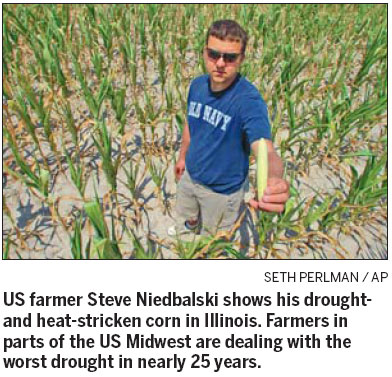Wide-reaching drought stifles US corn yield

The United States, reeling from a harsh Midwest drought, slashed its forecast for its 2012-13 corn crop on Wednesday, saying yields will be even worse than expected a month ago.
Still, it's unclear if importers such as China will see higher crop prices and reduced supplies of corn, soybeans and other US farm products as a result.
Of countries that import US agricultural products, China buys the second-largest amount of corn, after Japan, and the largest amount of soybeans.
The US Department of Agriculture estimated that the country's farmers will harvest 12.97 billion bushels, or 329.5 million metric tons, of corn in the 2012-13 season, down 12 percent from a prediction the department made in June, when it said the harvest would be 14.79 billion bushels.
An average of analysts' estimates compiled by Bloomberg News had expected a corn yield of 13.53 billion bushels during the period.
Inventories before the harvest in late summer and fall could be down by as much as 37 percent, from what was forecast last month, or down to 1.183 billion bushels.
The drought, the worst to hit the United States since 1988, is affecting places stretching from Ohio to California. Although not as severe as the dry spell that hit the Southwest in 2011, the conditions are affecting more farmland and are undermining the hopes for a record crop that arose after the planting season this year.
In the marketing year that begins on Sept 1, China is forecast to import 5 million tons of corn from the US, which grows and exports more corn than any other country, according to the USDA. That's down 2 million tons from previous estimates.
The price of US corn futures jumped in early trading in response to Wednesday's grim news, but settled lower than on the previous day, showing that traders had already taken into account the likely effects of the drought.
The price of corn for July delivery fell by 10.25 US cents, or 1.3 percent, to nearly $7.51 a bushel on the Chicago Board of Trade. Wednesday's settlement price for December-delivery corn was $7.04 per bushel, down 13.5 US cents, or 1.9 percent.
Also on Wednesday, the USDA declared that more than 1,000 counties in 26 states, mostly in the Midwest and Southwest, were natural-disaster areas, largely because of the presence of drought and wildfires in those areas. The declaration makes farmers and ranchers in the counties eligible to receive low-interest government loans to help them through the hardships.
In Indiana, one of the disaster-area states, exports of corn and soybeans are "likely to be greatly reduced", said Chris Hurt, a professor of agricultural economics at Purdue University.
In Minnesota, which instead of suffering drought, has been benefited from ample rainfall this spring and summer, Su Ye, state agriculture department market research director, said "the supply and price of our agricultural exports to China will be stable".
China is the single biggest market for Minnesota's farm exports, she said.
Iowa, which produces large amounts of corn and soybeans and is not on the USDA disaster list, is still assessing how the conditions may affect its exports.
"It's too early to tell," said Dustin Van de Hoef, a spokesman for Iowa's Department of Agriculture and Land Stewardship.
"China is a key trading partner for Iowa farmers, and all US agriculture and farmers are committed to continue meeting the needs of our trading partners in China."
Contact the writers at yuweizhang@chinadailyusa.com and josephboris@chinadailyusa.com
(China Daily 07/13/2012 page13)












